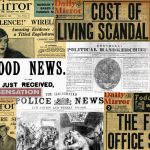This week at The Archive we have been beavering away to bring you 266,469 brand new pages from across the world, from Canada to Ireland, from the United States to Wales. We are delighted to introduce six brand new titles to our collection, including our first ever title from the United States, alongside another new title that was exclusively devoted to all things Anglo-American. Meanwhile, we welcome a brand new Canadian title to our collection, just in time for Canada Day, whist we’ve added two new titles from Ireland and another from London over the past seven days.
So read on to find out more about all of our new and updated titles of the week, and also to discover more about the centennial celebrations of the Declaration of Independence, which took place in the United States, of course, and back across the pond in Great Britain, in 1876.
Register now and explore the Archive
First up we’re delighted to welcome an eminently historic newspaper from the United States to our Archive, which is the Gazette of the United States. An early American newspaper, the Gazette of the United States was first published on 15 April 1789 in New York. Its first ever edition, which you can view here, stated its ‘plan’ to be a ‘national newspaper…to be Published at the Seat of the Federal Government.’ Indeed, it listed nine different items that it would aim to include, which ran as follows:
- EARLY and authentick Accounts of the Proceedings of Congress – its Laws, Acts, and Resolutions…
- Impartial Sketches of the Debates of Congress
- Essays upon the great subjects of Government in general…
- A Series of Paragraphs, calculated to catch the ‘Living Manners As They Rise,’ and to point the publick attention to Objects that have an important reference to domestick, social, and publick happiness.
- The Interests of the United States as connected with their literary Institutions – religious and moral Objects – Improvements in Science, Arts, Education and Humanity – their foreign Treaties, Alliances, Connections &c.
- Every species of Intelligence, which may affect the commercial, agricultural, manufacturing, or political Interests of the American Republick
- A Chain of Domestick Occurences, collected through the Medium of an extensive Correspondence with the respective States.
- A Series of Foreign Articles of Intelligence
- The State of National Funds

Founded by editor John Fenno (1751-1798), the Gazette of the United States supported the Federalist Party, the first political party in the United States, and indeed the newspaper was considered to be a semi-official organ of the government. Filling four pages, and costing six pence, the newspaper contained an ‘Epitome of the Present State of the Union,’ chronicling the news from New Hampshire, Massachusetts, Connecticut, Delaware, Maryland, West Virginia, South Carolina, New Jersey and Pennsylvania. It also looked at news from the ‘Foreign States’ of Rhode Island and North Carolina, which had not yet ratified the United States constitution.
Meanwhile, the Gazette of the United States took an in-depth look at the ‘Proceedings of Congress’ and ‘Congressional Affairs,’ whilst also reporting on various industries like agriculture and the fur trade. Furthermore, the newspaper printed an array of political essays, contributed by the likes of John Adams and Alexander Hamilton.

In 1790 the Gazette of the United States moved with the nation’s new capital to Philadelphia, and a year later a rival to the publication, the National Gazette, was founded. The National Gazette, however, only lasted for a few years, and the newspaper’s next rival was the Philadelphia Aurora, which was edited by Benjamin Franklin Bache. Bache and Fenno only met once; the encounter saw them fighting in the streets. But both men would succumb to an outbreak of yellow fever in Philadelphia in 1798, Fenno’s newspaper then passing between various figures, before it was consolidated into another newspaper in 1818, the final edition of the Gazette of the United States appearing on 7 March 1818.
And we stay with our American theme to introduce our next new title of the week, which is the Anglo-American Times. This weekly publication, which dubbed itself as an ‘international commercial, and general newspaper,’ was printed in London and was first published on 27 October 1865. True to its title, the Anglo-American Times aimed to ‘reproduce the best articles from the leading American papers,’ promising to feature ‘a review of the week’s history of the United States.’

Initial reviews of the new newspaper were positive, a contemporary newspaper dubbing it ‘a well-printed and exceedingly readable journal.’ Indeed, the review went on to further state the aims and intentions of the Anglo-American Times:
It professes to make itself the organ of those interests and political subjects in which Great Britain and the United States are mutually concerned. In addition to complete commercial information, a column will be devoted to American tourists who wish to communicate their arrival or sojourn at London, Paris, or any other European city.
So what could you find across the sixteen pages of the Anglo-American Times? The newspaper featured the ‘Latest American Intelligence,’ from the ‘Southern States,’ the ‘Middle States,’ as well as from New England. It also took a look at the ‘Spirit of the Public Journals’ from America, with various articles devoted to American subjects, like ‘Connecticut and Free Suffrage,’ a look at the past and present of South Carolina, and the American cotton industry.

Indeed, the Anglo-American Times was printed at a pivotal time in the history of the United States, as the country began to rebuild after the American Civil War, and this theme of reconstruction is evident throughout the London-based journal. For example, early articles looked at the ‘Dispersion of the Army in the United States’ after the end of the conflict. The newspaper was neutral in its politics, and also contained poetry, religious news and shipping reports.
We stay across the pond now for our next new title of the week, although we move slightly further north, to introduce the Ottawa Free Press to our collection, the fourth Canadian title to join The Archive. Established in the Canadian capital of Ottawa in 1869, the Ottawa Free Press was a ‘Liberal and Reform journal’ that appeared daily, barring Sundays. Founded two years after the Dominion of Canada was established as a self-governing entity within the British Empire, the newspaper was firmly in support of Canadian Home Rule.

Costing one cent, the Ottawa Free Press featured national and international news, as well as ‘Local Briefs’ from Ottawa. The newspaper had a particular focus on sport, featuring reports on hockey, rowing, golf and boxing, as well as reporting on ‘Political Gossip’ and the ‘Women of Ottawa.’ A particularly interesting feature of the Ottawa Free Press was its ‘Return of Convictions’ section, which listed the names of those charged in Carleton County, the nature of their charges and the date of their conviction.
Dubbed a ‘stout Reform journal’ by contemporary newspaper the Toronto Daily Mail, the Ottawa Free Press also contained obituaries, weather news, and later on, a ’25 years ago today’ feature.
We travel back across the Atlantic and to London now to welcome the Wallington & Carshalton Herald to The Archive. Established in Wallington, a suburb of south London that lies within the Borough of Sutton, in 1878, the Wallington & Carshalton Herald was Conservative in its politics, and appeared every Saturday. With the full title of the Wallington & Carshalton Herald, Mid and West-Surrey Advertiser, this thorough local paper covered the news from Wallington and Carshalton, as well as from Ashstead, Banstead, Beddington, Bookham, Cheam, Dorking, Epsom, Ewell, Fetcham, Leatherhead, Mickleham, Mitcham, Morden and Sutton.

Costing just one pence, with editions published for Epsom and for Sutton, the Wallington & Carshalton Herald contained ‘Local Intelligence’ from across the area, with a look at the Epsom District Highway Board, the Croydon Board of Guardians, and the highways of Sutton. The newspaper also contained special interest features, including a ‘Ladies’ Column’ devoted to ‘Dress and Fashion,’ a gardening column, and a ‘Useful Hints’ section, which was devoted to a range of different recipes. Meanwhile, the Wallington & Carshalton Herald published ‘Original Correspondence,’ national news, and the latest from London.
We’re travelling across the Irish Sea now to introduce our final two new titles of the week. And our penultimate new newspaper this week is the East Galway Democrat, which was first published in 1910 and circulated in the counties of Galway and Roscommon. Nationalist in its politics, the East Galway Democrat was published in Ballinasloe, a town in the east of County Galway.

Appearing every Friday at the cost of two pence, the East Galway Democrat filled eight pages and concentrated on local news, with updates on the area’s fairs and from the Ballinasloe Board of Guardians. Meanwhile the newspaper also featured news from across Ireland, with especial focus on the fight for Home Rule. The East Galway Democrat ceased publication in 1949.
Our final new title of the week is the Munster Tribune, which was first published on 10 June 1955 in Clonmel, the county town of County Tipperary. Filling fourteen pages, with ‘all the news in print and pictures,’ its first edition laid out its mission statement:
This is the first issue of a newspaper which we believe in all sincerity will bring something new to journalism in this part of the country. The area has long needed a paper which will be in touch with all the people and which will reflect every facet of their life. ‘The Munster Tribune’ will present a week-by-week account of the activities, the public events, the social life, the sports, the amusements – in short, of the whole life of one of the richest, one of the most historic and one of the most charming parts of Ireland.

The Munster Tribune, therefore, promised to serve wholeheartedly its local community, providing a robust record of local residents’ work and their play. To this end, the newspaper printed local news and pictures, printing a section entitled ‘Clonmel Commentary’ and one feature named ‘Our Strolling Cameraman.’ Meanwhile, the Munster Tribune featured reports on weddings, obituaries, and on local elections. Finally, the lively local newspaper provided commentary on the area’s sporting events, reporting on soccer, hurling and athletics.
That’s it from our wonderful new titles of the week, but there’s more! We’ve updated fourteen of our existing titles from across the world over the past seven days, with additions to last week’s new Caribbean titles, which include the Mirror (Trinidad & Tobago) and the Dominica Chronical. Meanwhile, we’ve added new pages to titles from across the United Kingdom and Ireland, from Wales (the Llanelli Star and the Carmarthen Journal), from Scotland (the Irvine Herald), from Ireland (the Cork Weekly Examiner) and from England (the Stanmore Observer).
Marking One Hundred Years Since the Declaration of Independence – July 1876
With Independence Day, or the Fourth of July, just around the corner, we thought we’d take a look at how the centenary of the Declaration of Independence was celebrated, using our new title the Anglo-American Times. The Declaration of Independence was ratified on 4 July 1776, and declared that the Thirteen Colonies were no longer subject to King George III. The Thirteen Colonies were now united, free and independent states, and would then become known as the United States of America in September 1776.
And one hundred years on, the United States geared up to celebrate the centenary of the Declaration of Independence, with the Anglo-American Times detailing how the anniversary was marked both in America, and in Great Britain.

Celebrations, however, started early, well before 4 July 1876, with the dawn of the new year. The Anglo-American Times on 7 January 1876 reported how:
At midnight, last Friday, began the Centennial Year of American Independence, which was celebrated throughout the Union with salutes, illuminations, and processions. Philadelphia will be the centre of attraction; and the greatest rally was around Independence Hall, where the Mayor, Mr. Stokley, in the presence of 100,000 people, hoisted a fac simile of the flag which Washington raised on that building in 1776.
Philadelphia was the locus of the celebrations, because the city was where the Declaration of Independence was adopted back in 1776. And the celebrations there were spectacular, as the Anglo-American Times described on 21 January 1876:
The advent of the Centennial year was celebrated at the Church of St Augustine, at Fourth below Vine street Philadelphia, by a general illumination. The body of the church was lighted by over 200 gas jets, while the cupola was ablaze with wax tapers. Over the main portal was the inscription, in burning letters, ‘Mater Consolationis,’ while both the Fourth and Crown street fronts of the spacious school house were illuminated by more than 1000 tapers. American and Irish flags floated from the domes and windows of the group of buildings, and at midnight the bell rang out a welcome to the Centennial of American Independence.

The article went on to report how:
The Centennial Rooms were very brilliantly illuminated, and attracted a throng of spectators. The office of the U.S. Centennial Commission, 903 Walnut street, was illuminated by means of lights placed behind the flags of different nations, producing a very fine effect. At the office of the Board of Finance, 904 Walnut street, the windows were filled with clusters of lights, and above the doorway there was a painting of the national flag.
The streets of Philadelphia were thronged with processions, ‘headed by bands of music.’ All in all, the Anglo-American Times concluded how ‘With all the crowding and confusion every one appeared to be a in a good humour and bent on commencing the New Year happily.’

But would the Fourth of July be celebrated in Britain, the country from which the United States gained independence one hundred years before? It would be, at least by Americans residing in the country, as the Anglo-American Times reported on 23 June 1876. The newspaper detailed how a circular had been issued from 57 Charing Cross, which read as follows:
The approaching Centenary of American Independence has been deemed by a large number of American citizens residing in London, a suitable occasion for a social gathering in commemoration of that event. It has, therefore, been resolved to hold a dinner on July 4th next, at the Westminster Palace Hotel, at 7 o’clock.
The centenary would be marked in London, therefore, by a special dinner, with tickets available at the cost of 30 shillings ‘for gentlemen,’ and at the price of 25 shillings ‘for ladies.’ Tickets would be allocated on a first come, first served basis.

Meanwhile, celebrations across the pond extended beyond dinners at hotels. Our newspapers from 1876 contain wonderful images of the parades, and the pageantry, that greeted the hundredth anniversary of the Declaration of Independence, which was signed nearly 250 years ago.

New Titles
Title | Years Added |
| Anglo-American Times | 1865-1896 |
| East Galway Democrat | 1913-1921, 1936, 1938-1949 |
| Gazette of the United States | 1789-1798, 1803 |
| Munster Tribune | 1955-1959, 1961-1962 |
| Ottawa Free Press | 1904-1909, 1911-1915 |
| Wallington & Carshalton Herald | 1882-1897 |
Updated Titles
This week we have updated fourteen of our existing titles.
You can learn more about each of the titles we add to every week by clicking on their names. On each paper’s title page, you can read a FREE sample issue, learn more about our current holdings, and our plans for digitisation.
Title | Years Added |
| Brentwood Gazette | 1990 |
| Carmarthen Journal | 1998 |
| Colonial Standard | 1889 |
| Cork Weekly Examiner | 1897 |
| Derbyshire Times | 1919, 1927 |
| Dominica Chronicle | 1910 |
| Dominica Guardian | 1921 |
| Ellesmere Port Pioneer | 1990 |
| Harrow Observer | 1987 |
| Irvine Herald | 1989 |
| Llanelli Star | 1991 |
| Mirror (Trinidad & Tobago) | 1901-1902, 1908, 1914-1915 |
| Stanmore Observer | 1991 |
| Westerham Herald | 1890 |
You can keep up to date with all the latest additions by visiting the recently added page. You can even look ahead to see what we’re going to add tomorrow.






